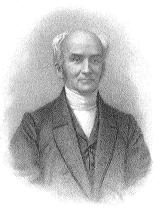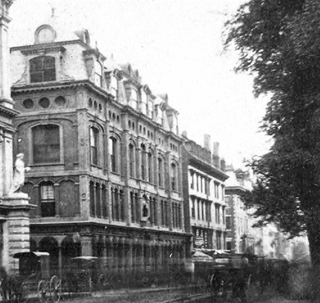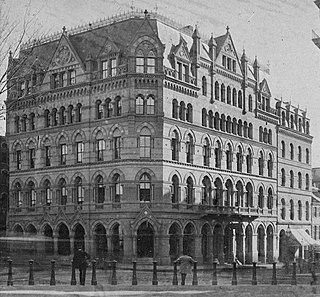Images
- Advertisement, 1889
- Seating chart, 1880s
- Advertisement, 1890
- Advertisement, 1891
- "Mrs. Herne as Margaret Fleming," 1891; depicts actress Katherine Corcoran
- Detail of map of Boston in 1896, showing Chickering Hall opposite Boston Common
Chickering Hall (est.1883) was a concert auditorium in Boston, Massachusetts, in the late 19th century. It occupied the second floor of Chickering and Sons showrooms on Tremont Street, near the corner of West Street. [1] [2] "Bradlee, Winslow and Wetherell were the architects, and Mr. E.P. Treadwell, the decorator. The hall [was] lighted by the Edison electric light." [3] [4] By 1895: "Tremont St., towards Boylston, for some years has been called Piano Row, for a long row of piano agencies occupied a good portion of the block; but of late most of these have migrated to Boylston St. Chickering Hall, at 152 Tremont St., was for many years a favorite place for fashionable musicales, and the headquarters of the musical profession." [5]
1880s | 1890s
|

The Cutler Majestic Theatre at Emerson College, in Boston, Massachusetts, is a 1903 Beaux Arts style theater, designed by the architect John Galen Howard. Originally built for theatre, it was one of three theaters commissioned in Boston by Eben Dyer Jordan, son of the founder of Jordan Marsh, a Boston-based chain of department stores. The Majestic was converted to accommodate vaudeville shows in the 1920s and eventually into a movie house in 1956 by Sack Cinemas. The change to film came with renovations that transformed the lobby and covered up much of John Galen Howard's original Beaux-Arts architecture.
Chickering & Sons was an American piano manufacturer located in Boston, Massachusetts. The company was founded in 1823 by Jonas Chickering and James Stewart, but the partnership dissolved four years later. By 1830 Jonas Chickering became partners with John Mackay, manufacturing pianos as "Chickering & Company", and later "Chickering & Mackays" until the senior Mackay's death in 1841, and reorganized as "Chickering & Sons" in 1853. Chickering pianos continued to be made until 1983.

Timothy Gilbert was an American piano manufacturer, abolitionist and religious organizer in Boston, Massachusetts. His brother Lemuel Gilbert was also a piano manufacturer.

Tremont Street is a major thoroughfare in Boston, Massachusetts.

The Boston Museum (1841–1903), also called the Boston Museum and Gallery of Fine Arts, was a theatre, wax museum, natural history museum, zoo, and art museum in 19th-century Boston, Massachusetts. Moses Kimball established the enterprise in 1841.

The Studio Building (1861–1906) on Tremont Street in Boston, Massachusetts, housed artists' studios, theater companies and other businesses in the 19th century. It "held the true Bohemia of Boston, where artists and literati delighted to gather." Among the tenants were portraitist E.T. Billings, architect George Snell, sculptor Martin Milmore, artists William Morris Hunt, William Rimmer, Edward Mitchell Bannister, Phoebe Jenks; gallerist Seth Morton Vose, and many others.

Tremont Row (1830s-1920s) in Boston, Massachusetts, was a short street that flourished in the 19th and early-20th centuries. It was located near the intersection of Court, Tremont, and Cambridge streets, in today's Government Center area. It existed until the 1920s, when it became known as Scollay Square. In 1859 the Barre Gazette newspaper described Tremont Row as "the great Dry Goods Street of Boston."
Beethoven Hall (1874–78) was an auditorium in Boston, Massachusetts, that hosted musical performances and other entertainments in the 1870s. It sat on Washington Street, near Boylston Street, in today's Boston Theater District/Chinatown neighborhood. The architect was William Washburn, who had also designed the first National Theatre and the second Tremont Temple.

The Park Theatre (est.1879) was a playhouse in Boston, Massachusetts, in the late 19th and early 20th centuries. It later became the State cinema. Located on Washington Street, near Boylston Street, the building existed until 1990.

The Bowdoin Square Theatre (est.1892) in Boston, Massachusetts, was a playhouse and cinema. It was located on Bowdoin Square in the West End, in a building designed by architect C.H. Blackall. Personnel included Charles F. Atkinson and William Harris. Audience members included future magician Julius Linsky and future actor Joseph Sicari

The Tremont Theatre was a playhouse in Boston, Massachusetts, in the late 19th and early 20th centuries. Henry E. Abbey and John B. Schoeffel established the enterprise and oversaw construction of its building at no.176 Tremont Street in the Boston Theater District area. Managers included Abbey, Schoeffel and Grau, Klaw & Erlanger, Thos. B. Lothan and Albert M. Sheehan.

Chickering Hall (1901–1912) was an auditorium in Boston, Massachusetts, located on Huntington Avenue in the Back Bay. It stood adjacent to Horticultural Hall. Tenants included the Emerson College of Oratory and D.M. Shooshan's "Ladies' and Gents' Cafe." In 1912 it became the St. James Theatre, and later the Uptown Theatre. The building existed until 1963, when it was demolished.
The Plymouth Theatre (1911–1957) of Boston, Massachusetts, was located on Stuart Street in today's Boston Theater District. Architect Clarence Blackall designed the building for Liebler & Co. Performers included Henry Jewett, Bill "Bojangles" Robinson, 8-year-old Sammy Davis, Jr., and Bette Davis. In October 1911, the touring Abbey Theatre presented Synge's Playboy of the Western World at the Plymouth; in the audience were W. B. Yeats, Isabella Stewart Gardner and Rose Fitzgerald Kennedy.

The Fenway Theatre (1915–1972) of Boston, Massachusetts, was a cinema and concert hall in the Back Bay, located at no.136 Massachusetts Avenue at Boylston Street.
The National Theatre (1911-1978) of Boston, Massachusetts, was a 3,500-seat multipurpose auditorium on Tremont Street in the South End. It functioned as a cinema, lecture hall, and stage. Performers included Jehovah's Witness founder Joseph F. Rutherford and "big-name entertainers like Duke Ellington and Ray Bolger." Movie screenings included The Battle of Gettysburg in 1913. The English High School held graduation exercises in the National. Around 1919 it was known as the "Waldorf Theater." In 1992, it was purchased by Philip Smith.
The St. James Theatre (1912–1929) of Boston, Massachusetts, was a playhouse and cinema in the Back Bay in the 1910s and 1920s. It occupied the former Chickering Hall on Huntington Avenue near Massachusetts Avenue, adjacent to Horticultural Hall. For some years Loew's theatre chain oversaw the St. James. In 1929 the theatre "became part of the Publix (Paramount) chain, and was renamed the Uptown."

Horticultural Hall (1865–1901) of Boston, Massachusetts, was the headquarters of the Massachusetts Horticultural Society in the later 19th century. It stood at no.100-102 Tremont Street, at the corner of Bromfield Street, opposite the Granary Burying Ground. Architects Gridley J.F. Bryant and Arthur Gilman designed the building. Sculptor Martin Milmore created horticulturally-themed statuary for the building's exterior: "three ancient Roman goddesses ... Ceres, goddess of agriculture; Flora, goddess of flowers; and Pomona, goddess of fruit trees." In the 1880s: "the ground floor [was] occupied by stores; the second story by the Library Room of the society and a hall for the weekly exhibitions; and the upper story by a large and elegant hall used ... at the annual and other important exhibitions. Both of these halls [were] often used for concerts and the better class of entertainments. The society's library, comprising over 4,000 volumes, [was] the most valuable collection of horticultural works in the United States. The halls [were] adorned with portraits and busts of the presidents, founders, and benefactors of the society."
Hotel Touraine (1897-1966) in Boston, Massachusetts, was a residential hotel on the corner of Tremont Street and Boylston Street, near the Boston Common. The architecture firm of Winslow and Wetherell designed the 11-story building in the Jacobethan style, constructed of "brick and limestone;" its "baronial" appearance was "patterned inside and out after a 16th-century chateau of the dukes of Touraine." It had dining rooms and a circulating library. Owners included Joseph Reed Whipple and George A. Turain.

Hotel Boylston (1871-1894) of Boston, Massachusetts, stood at the corner of Tremont Street and Boylston Street in today's Boston Theater District. The architecture firm of Cummings and Sears designed it "in the Italian-Gothic style" as a residential apartment building. Among the tenants: New England Kennel Club; Christian Science Publishing Co.; and piano dealer Steinert & Sons and its 350-seat concert hall.

Steinert Hall of Boston, Massachusetts, stands at 162 Boylston Street on what was called Boston's "piano row", opposite the Common in the Boston Theater District.